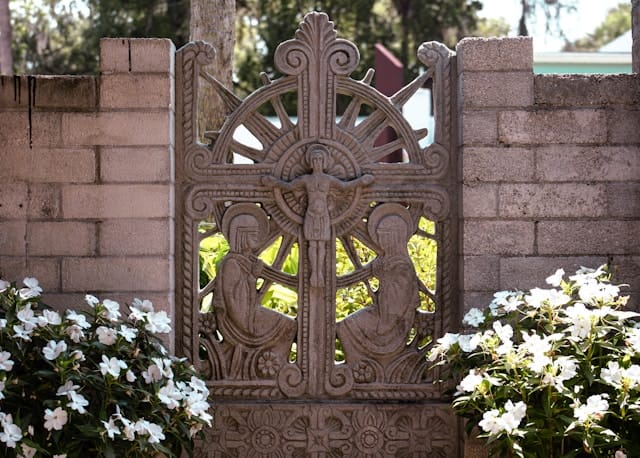Myth is Not a Dirty Word: On the Feast of St John the Evangelist

Why is this place named The Church of St John the Evangelist? Why not St Joseph’s, like the Roman Catholic parish across the street? Why not St Mary’s or St Matthew’s? Why not Charlton Avenue Anglican Church? The history of naming important sites for saints and aspects of God is a very old one. The practices connected to those names have changed over the years, but the tradition continues.
As we’ve heard in the readings from the Acts of the Apostles through Eastertide, being a Christian in the earliest days of the Church was not always an easy or safe choice. Depending on where in the world one lived, the powers-that-were may have been indifferent to Christians. But, just as happens today, when a scapegoat for societal problems was needed, a minority religious group was the perfect target. Sometimes this meant Christians were barred from certain social activities. Sometimes it meant they were run out of town. Sometimes it meant they were killed.
When Christians were first killed for their faith, it produced an interesting conversation among the members of the community. I am generalizing greatly here, but the discernment of the Early Church around this persecution went like this: If the goal of Christian life is to be as much like Christ as possible, then dying as a result of murder by a power that is threatened by the Gospel is a very good way to die. Not something the Christians should seek out, but something that they should be ready to accept if it comes to them. Christians murdered for their faith were called martyrs, from the Greek word for “witness”.
Early Christian ideas about the afterlife generally believed that the dead waited for the Day of Judgement when all would be resurrected. The waiting was not unpleasant, often compared to a very deep, restful sleep. These martyrs, surely, did not need to wait to proceed to heaven. Having died in a manner just like that of our Lord, they would be admitted to the eternal bliss of heaven early. No further judgement or discernment about their fate was needed. They were, from the moment of death, singing endless praises around the throne of God in heaven.
After their executions, the remains of martyrs were often returned to their families to deal with. Nobody wanted the cost and responsibility of those bodies. For Christians, this was a great blessing. If our sibling in Christ, who lived and walked among us, is now standing at the throne of God in heaven but has also left some part of their body behind, there is a connection. The martyrs quickly became a bridge between heaven and the congregation here on earth.
It became the practice to visit the remains of these holy people and worship with them on a regular basis. At least once a year, on the anniversary of their death. When Christianity became legal and churches were built, many of the bodies and remains—called relics in churchland—were moved from catacombs up into the churches themselves. If these martyrs were gathered in the worship in heaven, then their earthly remains ought to be gathered in the worship on earth. There is a good and practical reason that our altars look like sarcophagi; they are an evolution of having a container for a saint’s body as the table at which the eucharist is celebrated. And, of course, if St Perpetua’s body is in the altar, the building becomes known as St Perpetua’s Church.
Anglicans do not often have saints’ relics in their altars these days, but the practice of naming a church for a saint or festival significant in its building and consecration remains. And, just like the ancient Christians celebrating eucharist in the catacombs on their martyr’s feast day, we continue to celebrate with special enthusiasm the saints for whom our local churches are named. We remind ourselves that every time we pray, give thanks, and worship, we do it surrounded by that great cloud of witnesses that is the communion of saints.
With this in mind, Saint John the Evangelist is our parish saint. Like an older brother in the faith, he looks out for us, prays for us, and, like all saints, offers a role model for us in what it means to live as Christians. The easy news about John is that, because he is one of the first disciples of Jesus and so involved in the earthly life and ministry of Christ, there is a lot for us to learn about John. The less easy news about John is that, like with any larger-than-life character, over the years the tales of John have changed. To quote the opening of Peter Jackson’s The Fellowship of the Ring, “Some things that should not have been forgotten were lost. History became legend. Legend became myth.” But, when it comes to Christians and saints, myth is not a dirty word.
John is present throughout the Bible, in Jesus’s ministry and travels. As with any ancient history, modern scholars will argue the details, but it is generally believed that John was a son of Zebedee and that he was present for the raising of Jairus’ daughter, the Transfiguration vision, and the Agony in the Garden of Gethsemane. John is identified as the Beloved Disciple in the Gospel attributed to him.
John is also present at the foot of the cross at the Crucifixion, where Jesus said to his mother, “Woman, here is your son.” Then he said to the disciple, “Here is your mother.” (John 19.26-27) Today’s feast coincides with our civic Mother’s Day and this moment in the lives of John and Mary deserves a moment of reflection. Mary is a widow and Jesus will soon be dead, but she does not require a caretaker. Jesus has a brother, James, who would be responsible for the care of their mother. John has a mother and does not need a second one. This moment is not about their material care. It is a statement, from the cross, that the followers of Jesus are, indeed, family. That there are real bonds formed here, in this Christian life, which make us mothers and sons, parents and children, ancestors and descendants, by the ways in which we choose to live with and love one another. Alongside our biological families, there is a spiritual family here, ordained by God, to be honoured and cherished.

From here, we move into murkier territory in the tradition of Saint John. Traditionally, John is the author of three epistles in the New Testament and the Revelation. Scholars disagree on whether this is possible, given the timespan across which these were written, and disagree on who the authors might truly be. Likewise, the tales of John’s life take on a mythical quality after the events of the Bible.
As the tradition goes, John worked many miracles of exorcism and healing, just like Jesus, including the resurrection of a girl named Drusiana, mirroring the story of Lazarus. On meeting two young men who gave away their wealth to the poor but regretted doing so, John turned a pile of sticks and stones into gold and gems, giving it to them and saying, “Here, you have received your reward; there will be nothing in heaven for you.”
John spent much of his apostolic career in and around Ephesus. One day, a priest of the great temple of Artemis there confronted him with a goblet of wine, saying that he would convert to Christianity if John could demonstrate Christ’s power by drinking poisoned wine without being harmed. To prove the effectiveness of the stuff, the priest forced two condemned prisoners to drink it, both of whom died. John took the cup, gave thanks to God, and, at the apostle’s blessing, a serpent crawled out of the goblet. John drank the wine and remained in perfect health before returning the two prisoners to life and good health. The priest did, indeed, convert. This is where the tradition of blessing wine and other drinks on St John’s day comes from, always with the prayer that they will be shared to our good health, never to our peril.=
As with the other apostles, John’s teaching and miracles were not well-received by those in power. The Romans arrested him and tried to martyr him by boiling him in oil. John lolled in the oil, treating it like a refreshing bath, not only unharmed but rejuvenated when they finally pulled him out. (There is a church in Rome called the Church of St John in Oil.) Eventually fed up with him, the emperor exiled him to the island of Patmos, a sparsely-populated, distant place where, presumably, John could not interfere. Tradition says it was here that he received the vision of the Revelation contained in the Bible.
This tradition and these stories about our older brother, our parish patron, are wild. They’re great fun. Some of them are probably, some of them are plausible, some of them seem like the stuff of comic books and fantasy novels. But, in every one of the stories about John, no matter how believable or not we might find them, the storyteller is trying to communicate something true about God to us. Something about what God has done and is doing in our midst. Something about the way we are meant to live as beloved disciples of God ourselves. Something about what it means to be, just like our brother John, an utterly ordinary person who has their entire life changed by an encounter with Jesus.
Blessed and happy feast of Saint John the Evangelist, one and all.





